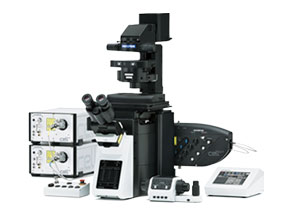"spINBRE TIRF": Olympus Spinning Disc Confocal Microscope with Total Internal Reflection Fluorescence
In recent years, Total Internal Reflection Fluorescence (TIRF) microscopy has become an important method for studying molecular interactions near the cell surface. To accommodate the trend of the development in life science research, CASI houses an advanced Olympus spinning-disc confocal microscope, which has an MITICO TIRF system with cutting-edge optic technology, an advanced laser system, and rapid imagine capability which ensures that researchers can observe fast subcellular processes and perform accurate localization studies with true, simultaneous multi-color TIRF. This instrument was purchased with funds provided by NIH Wyoming INBRE that is supported by an Institutional Development Award (IDeA) from the National Institute of General Medical Sciences of the National Institutes of Health under Grant # 2P20GM103432. User rates are subsidized by the same award.

Instrument Highlights
- Ultra-Sensitive Multicolor TIRF:
The MITICO cellTIRF-4Line system enables ultra-sensitive, simultaneous multicolor TIRF imaging using four laser channels with independent beam paths. Precise angle control ensures equal evanescent penetration, resulting in high-contrast images with minimal background noise.
- Cutting-edge optics:
The Olympus 100x TIRF objective with an NA of 1.5 PLAN provides precise angle control and shallow penetration depth, offering a significant advantage for examining cell membranes and enabling investigations with single-molecule precision.
- User-Friendly Interface:
Switching between different illumination modes, including widefield burner, widefield laser illumination, critical angle, or preset penetration depths, is as simple as pushing a button. The Experiment Manager allows you to adjust penetration depth during experiments.
- HILO Microscopy:
Our system is optimized for highly inclined laminated optical sheet (HILO) microscopy, enhancing image intensity while reducing background intensity. This is particularly useful for observing light-sensitive samples and conducting time-lapse studies.
- Point FRAP Integration:
The Olympus cellTIRF-4Line system includes integrated point FRAP optics for the first laser line. This feature enables FRAP and photo-switching experiments without additional cost, offering a rapid switching time of 100 microseconds for exceptional data quality.
Specifications
| Feature | Specification |
| Microscope Model | Inverted Olympus IX83 |
| Confocal Scan Head | Yokogawa W1 Spinning Disc |
| Spinning Discs 1 |
50um pinhole disc for conventional confocal imaging |
| Lasers |
405nm, 488nm, 561nm, 640nm |
| Objective Lenses |
40x, 60x, 100x Silicone Oil |
| Camera |
One sCMOS camera for sequential, high-speed imaging |
| Imaging Modes |
DIC and Brightfield |
| Olympus MITICO TIRF system |
Lasers: 405nm, 488nm, 561nm, 642nm (642mW has 140mW power for STORM Imaging) |
| Objective: Olympus 100x TIRF objective NA 1.5 PLAN | |
| Live Imagine System | Tokai Hit heating incubation system for live cell imaging from room temperature to 60C |
| Location |
Science Initiative Building 1305 Bay 1 |
| Fee | Listed in Rates |
Contact Info & Location
Instrument Manager:
Instrument Location: Science Initiative Building Bay 1, 1305

